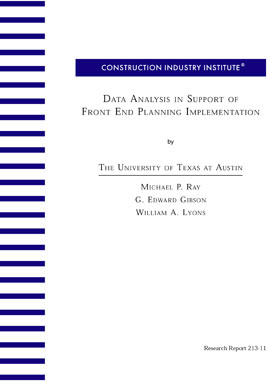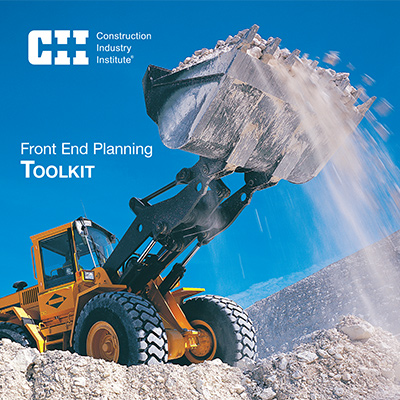
Data Analysis in Support of Front End Planning Implementation
Front end planning has long been recognized as an important process that increases the likelihood for a successful project. CII has performed several studies focused on front end planning over the past 15 years and considers pre-project planning (front end planning) to be a CII Best Practice. The term front end planning will be used throughout this research report in lieu of pre-project planning. In past research efforts, this process has been called various names such as pre-project planning, front end loading (FEL), programming/schematic design, scope definition and many other terms. It was decided by the research team guiding this effort that front end planning most accurately describes the activities involved.
Many organizations have incorporated a structured front end planning process into their project life cycle processes. Front end planning is defined as “the process of developing sufficient strategic information for owners to address risk and decide to commit resources to maximize the chance of a successful project.” This process generally encompasses three sub-phases: feasibility, concept, and detailed scope. In many organizations, each of these phases are checked at “phase gates” that must be passed prior to moving to a succeeding phase. Front end planning generally ends at phase gate three (after detailed scope) with project approval to move into detailed design and construction, unless the project is terminated at this or an earlier gate. This study focused on collecting data to support the use of a structured front end planning process on capital projects.
Alignment has also been recognized as an important factor during successful front end planning and is considered a CII Best Practice. Alignment is defined as “the condition where appropriate project participants are working within acceptable tolerances to develop and meet a uniformly defined and understood set of project objectives.” Data were collected in this study investigating alignment’s effect on the front end planning process and overall project success.
Most of the data included in this analysis were obtained from the CII Benchmarking and Metrics program, with the remainder from previous front end planning research conducted by the authors of this report. A total of over 600 projects were used in this analysis representing almost $37 billion in total installed cost. In addition, a survey of existing CII membership was conducted to determine the current usage of the Project Definition Rating Index (PDRI) scope definition tools. CII members returned 70 usage surveys.
This report consists mainly of analyses of front end planning metrics tracked by (CII) Benchmarking and Metrics program including:
- PDRI scores
- Pre-Project Planning (PPP) Index scores
- Percent design complete
- Alignment Index scores
These practice-use metrics are all compared to performance metrics, including cost, schedule, and change order performance. Results of the analyses show that better-planned projects generally outperform projects that are less defined in terms of project performance metrics. For example, projects with PDRI scores (at front end planning phase gate three) of 200 or less (lower is better for this index) are significantly better in terms of project performance metrics such as cost growth, schedule growth and change orders. Additionally, projects with the CII PPP Index scores above the median (higher is better for this index) of the sample show significantly better project performance in these same areas. Projects expending 20 percent or greater of total design work hours during the front end planning process have better design and construction performance in terms of cost growth.
A summary of front end planning phase costs for several different project types is also included. To adequately define a project, organizations in the sample spent approximately three to five percent of total project budget on front end planning prior to beginning detailed design and construction. These expenditure data are dependent on the project and are broken down into owner and contractor categories, as well as by project type in this study.
Finally, a survey of the status of PDRI usage by CII member organizations is included. Almost two-thirds of responding CII members are using one or both versions of the PDRI. The report details why, how, and when the PDRI is being used, along with its effectiveness.


